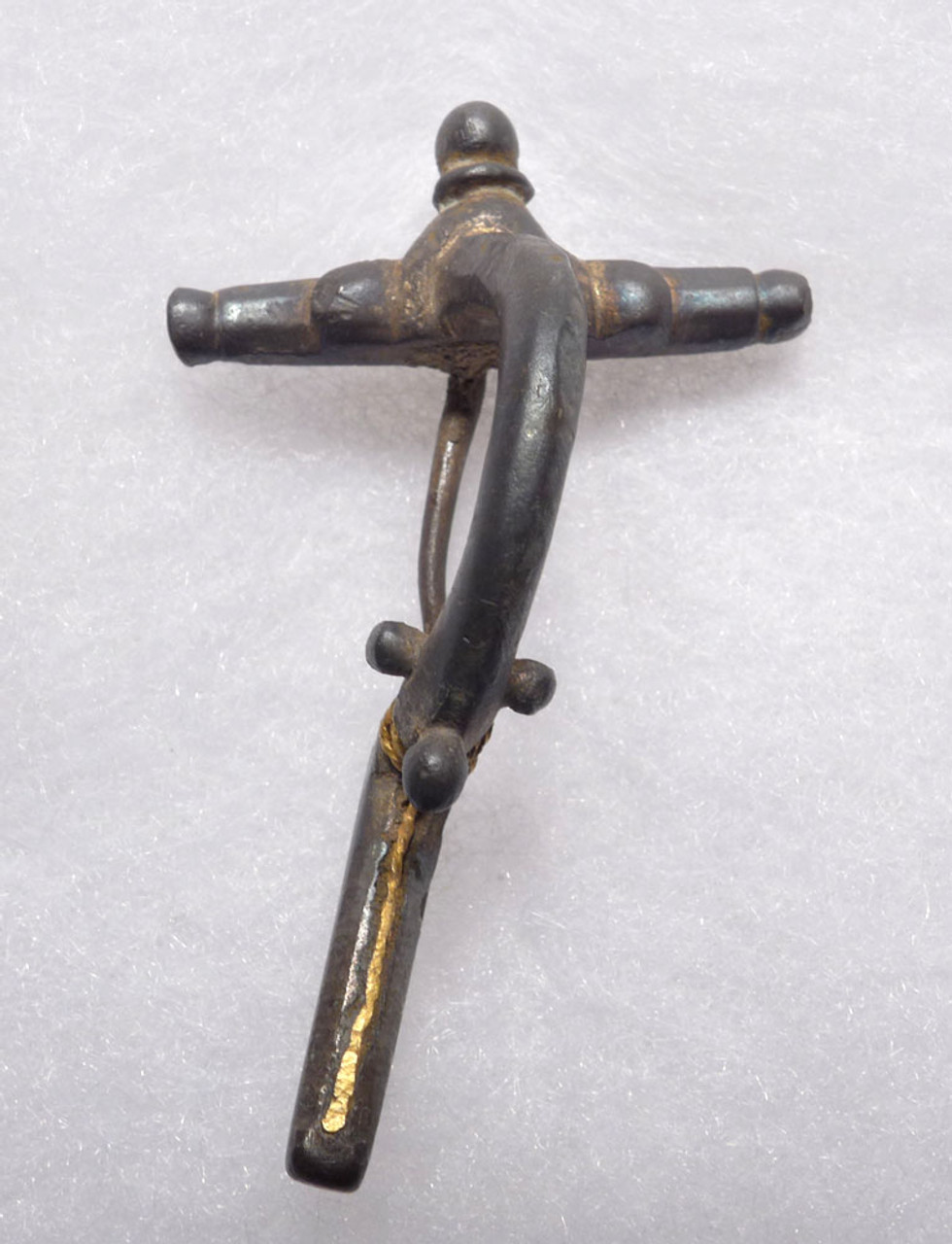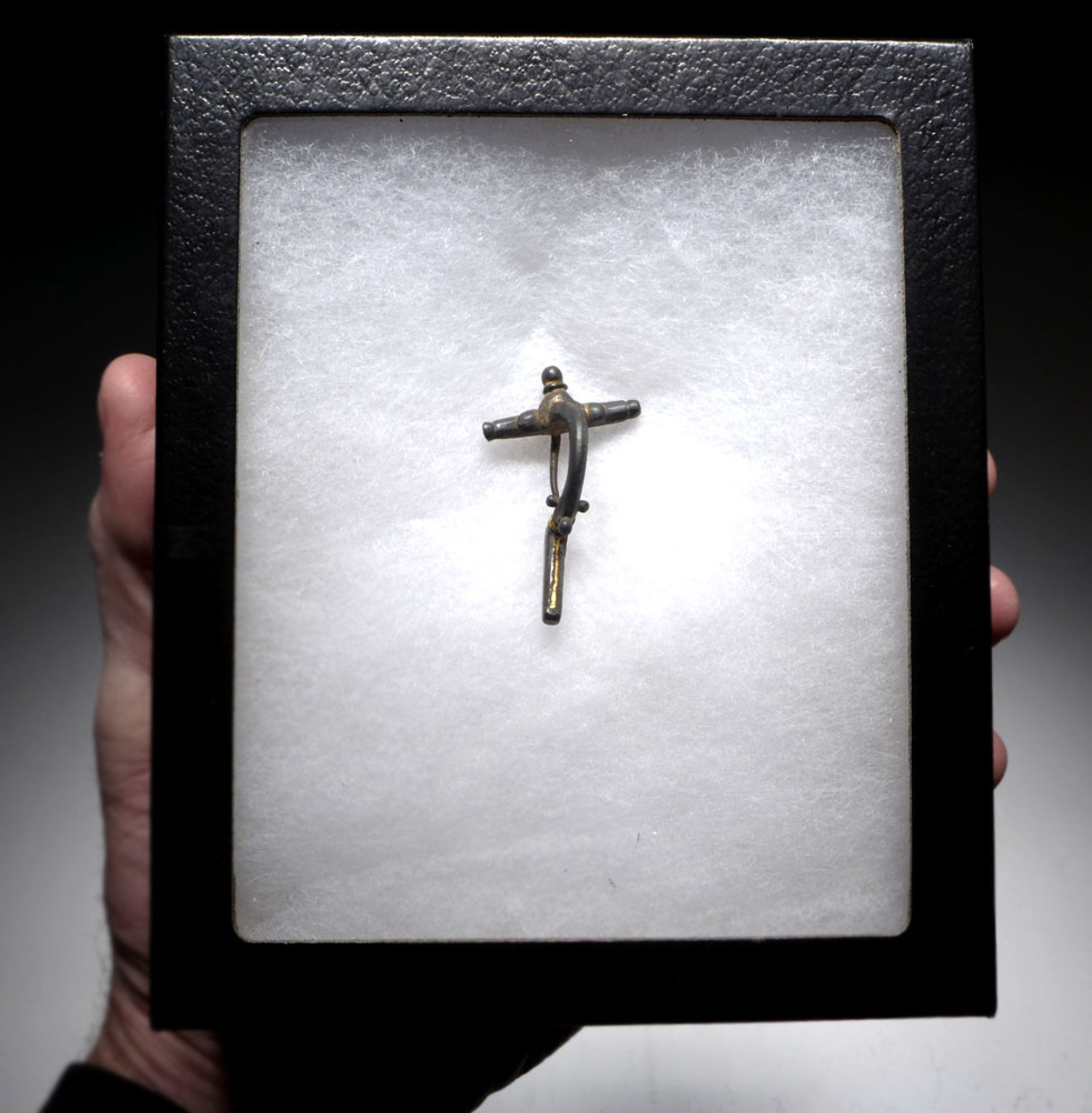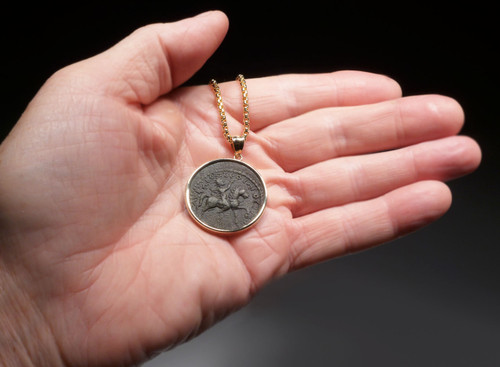Product Description
SEE MORE ANCIENT ROMAN ARTIFACTS
We have seen more than our fair share of ancient fibulae brooches and very few stand out as memorable. Couple that with the fact that there are so many fakes on the market, it is hard for a collector to find exquisite examples of this ancient object of utility, as well as status (much like a watch is in modern times). This is an exceptionally rare crossbow fibula brooch pin in precious silver and gold. This is THE ONLY precious metal ancient Roman fibula we have ever handled. While the vast majority of these were made of bronze, this RARE specimen is silver with a pure or nearly pure (22k) gold twisted wire wrap and inlay. The purity of the silver is uncertain but for strength, it would be less than sterling. The silver was formerly gilded with gold in ancient times, and traces of this gilding are still evident in the recesses and joints of the design. Adding to the rarity is the presence of the original stick pin in the back of the fibula. Often, these have fallen off or are broken off.
The main body of the fibula brooch has been bent indicating it was lost in ancient times and either, it was stepped on, or pressure from burial caused the deformity. This rare ancient Classic Roman luxury item would make an impressive addition to an advanced collection because of its scarcity. A fibula of this quality and level would have been reserved for only the wealthiest and highest class noble individuals as a piece like this in the Early Imperial Roman era, would have been extremely expensive, out of reach for the average Roman citizen.
If you collect fibula or want to have just one in your collection, do not settle for the common examples that abound in the market. This is an extremely rare example compared to the more prevalent types that would have graced ordinary folk in antiquity.
WARNING: Be wary of modern copies that have been around for many decades and sold to unsuspecting tourists, as well as found every day in online auctions and curio shops. In our own museum lab facility, we subject to rigorous inspection and authentic every artifact we offer for sale, accompanied by a written lifetime, unconditional guarantee of authenticity and proper identification.
HISTORY
A fibula (plural fibulae) is a brooch or pin for fastening garments. The fibula developed in a variety of shapes, but all were based on the safety-pin principle. Technically, the Latin term, fibulae, refers to Roman brooches; however, the term is widely used to refer to brooches from the entire ancient and early medieval world that continue Roman forms. Nevertheless, its use in English is more restricted than in other languages, and in particular post-Roman brooches from the British Isles are just called brooches (for example, the penannular brooches), where in German they would probably be fibulae.
Unlike most modern brooches, fibulae were not only decorative; they originally served a practical function: to fasten clothing, such as cloaks. Fibulae replaced straight pins that were used to fasten clothing in the Neolithic period and the Bronze Age. In turn, fibulae were replaced as clothing fasteners by buttons in the Middle Ages. Their descendant, the modern safety pin, remains in use today. In ancient Rome and other places where Latin was used, the same word denoted both a brooch and the fibula bone because a popular form for brooches and the shape of the bone were thought to resemble one another.
The Classic Roman Empire was a unique association of peoples and places such as the Mediterranean World had never seen before. What had been a patchwork of Hellenistic monarchies, independent city-states, and Celtic tribes was miraculously united into one great political entity. At its peak rule, the Roman Empire stretched from Spain to Syria and England to Egypt. Much of the success of the Empire can be attributed to the protection afforded by its near invincible war machine, the Roman army. Many tactics and weapons were first pioneered by this massive military force and just the thought of having to challenge this entity thwarted many a foreign enemy. Those that were brave (or foolish) enough to go up against Rome's military were quickly made examples of to the rest of the world. The technology and strength of the Roman military was the guardian of this great society in the West for some 500 years.
Our modern world today benefits much from a host of technological innovations first given to us by the ancient Romans. From simple inventions such as blown glass and underground sewer systems to major concepts in engineering and the Roman calendar.
 US DOLLAR
US DOLLAR
 EURO
EURO
 AUSTRALIAN DOLLAR
AUSTRALIAN DOLLAR
 CANADIAN DOLLAR
CANADIAN DOLLAR
 POUND STERLING
POUND STERLING
























